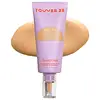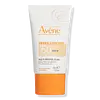What's inside
What's inside
 Key Ingredients
Key Ingredients

 Benefits
Benefits

 Concerns
Concerns

 Ingredients Side-by-side
Ingredients Side-by-side

Zinc Oxide 12.6%
Cosmetic ColorantWater
Skin ConditioningIsononyl Isononanoate
EmollientC9-12 Alkane
SolventButyloctyl Salicylate
Skin ConditioningPolyglyceryl-6 Polyricinoleate
EmulsifyingCaprylic/Capric Triglyceride
MaskingGlycerin
HumectantEthylhexyl Methoxycrylene
Skin ConditioningTrimethylsiloxysilicate
EmollientMica
Cosmetic ColorantPolyglyceryl-2 Isostearate
EmulsifyingSodium Chloride
MaskingPhenoxyethanol
PreservativeDisteardimonium Hectorite
StabilisingPolyglyceryl-3 Polyricinoleate
EmulsifyingPolyhydroxystearic Acid
EmulsifyingCoco-Caprylate/Caprate
EmollientIsostearic Acid
CleansingLecithin
EmollientPolyglyceryl-6 Polyhydroxystearate
EmulsifyingJojoba Esters
EmollientEthylhexylglycerin
Skin ConditioningSodium Phytate
Aloe Barbadensis Leaf Water
MaskingCentella Asiatica Extract
CleansingOpuntia Tuna Fruit
Skin ConditioningSalvia Officinalis Extract
AntimicrobialIron Oxides
CI 77891
Cosmetic ColorantZinc Oxide 12.6%, Water, Isononyl Isononanoate, C9-12 Alkane, Butyloctyl Salicylate, Polyglyceryl-6 Polyricinoleate, Caprylic/Capric Triglyceride, Glycerin, Ethylhexyl Methoxycrylene, Trimethylsiloxysilicate, Mica, Polyglyceryl-2 Isostearate, Sodium Chloride, Phenoxyethanol, Disteardimonium Hectorite, Polyglyceryl-3 Polyricinoleate, Polyhydroxystearic Acid, Coco-Caprylate/Caprate, Isostearic Acid, Lecithin, Polyglyceryl-6 Polyhydroxystearate, Jojoba Esters, Ethylhexylglycerin, Sodium Phytate, Aloe Barbadensis Leaf Water, Centella Asiatica Extract, Opuntia Tuna Fruit, Salvia Officinalis Extract, Iron Oxides, CI 77891
Zinc Oxide 12%
Cosmetic ColorantWater
Skin ConditioningJojoba Esters
EmollientCaprylic/Capric Triglyceride
MaskingC12-15 Alkyl Benzoate
AntimicrobialPropanediol
SolventPolyglyceryl-4 Diisostearate/Polyhydroxystearate/Sebacate
EmulsifyingTridecyl Salicylate
Skin ConditioningNylon-12
Niacinamide
SmoothingMethylpropanediol
SolventTitanium Dioxide
Cosmetic ColorantIron Oxides
Silica
AbrasiveGlycerin
HumectantSodium Chloride
MaskingCoco-Caprylate
EmollientPolyglyceryl-2 Dipolyhydroxystearate
Skin ConditioningCaprylyl Glycol
EmollientBisabolol
MaskingAllantoin
Skin ConditioningOryza Sativa Bran Extract
Skin ConditioningStearalkonium Hectorite
Gel FormingLecithin
EmollientPolyglyceryl-3 Diisostearate
EmulsifyingPolyglyceryl-3 Polyricinoleate
EmulsifyingPhenylpropanol
MaskingHelianthus Annuus Flower Extract
Skin ConditioningHydrogenated Lecithin
EmulsifyingAluminum Hydroxide
EmollientTocopherol
AntioxidantRosmarinus Officinalis Leaf Extract
AntimicrobialTetrasodium Glutamate Diacetate
Sodium Hydroxide
BufferingZinc Oxide 12%, Water, Jojoba Esters, Caprylic/Capric Triglyceride, C12-15 Alkyl Benzoate, Propanediol, Polyglyceryl-4 Diisostearate/Polyhydroxystearate/Sebacate, Tridecyl Salicylate, Nylon-12, Niacinamide, Methylpropanediol, Titanium Dioxide, Iron Oxides, Silica, Glycerin, Sodium Chloride, Coco-Caprylate, Polyglyceryl-2 Dipolyhydroxystearate, Caprylyl Glycol, Bisabolol, Allantoin, Oryza Sativa Bran Extract, Stearalkonium Hectorite, Lecithin, Polyglyceryl-3 Diisostearate, Polyglyceryl-3 Polyricinoleate, Phenylpropanol, Helianthus Annuus Flower Extract, Hydrogenated Lecithin, Aluminum Hydroxide, Tocopherol, Rosmarinus Officinalis Leaf Extract, Tetrasodium Glutamate Diacetate, Sodium Hydroxide
 Reviews
Reviews

Ingredients Explained
These ingredients are found in both products.
Ingredients higher up in an ingredient list are typically present in a larger amount.
This ingredient is an emollient, solvent, and texture enhancer. It is considered a skin-softener by helping the skin prevent moisture loss.
It helps thicken a product's formula and makes it easier to spread by dissolving clumping compounds.
Caprylic Triglyceride is made by combining glycerin with coconut oil, forming a clear liquid.
While there is an assumption Caprylic Triglyceride can clog pores due to it being derived from coconut oil, there is no research supporting this.
Learn more about Caprylic/Capric TriglycerideGlycerin is already naturally found in your skin. It helps moisturize and protect your skin.
A study from 2016 found glycerin to be more effective as a humectant than AHAs and hyaluronic acid.
As a humectant, it helps the skin stay hydrated by pulling moisture to your skin. The low molecular weight of glycerin allows it to pull moisture into the deeper layers of your skin.
Hydrated skin improves your skin barrier; Your skin barrier helps protect against irritants and bacteria.
Glycerin has also been found to have antimicrobial and antiviral properties. Due to these properties, glycerin is often used in wound and burn treatments.
In cosmetics, glycerin is usually derived from plants such as soybean or palm. However, it can also be sourced from animals, such as tallow or animal fat.
This ingredient is organic, colorless, odorless, and non-toxic.
Glycerin is the name for this ingredient in American English. British English uses Glycerol/Glycerine.
Learn more about GlycerinJojoba Esters is a wax created from Jojoba oil. It is an emollient and film-forming ingredient. In bead form, it is an exfoliator.
This ingredient has high oxidative stability, meaning it doesn't break down when exposed to oxygen.
Its similarity to our skin's natural oils makes it a great emollient. Emollients help soften and soothe our skin by creating a barrier on top. This barrier helps trap moisture in, keeping skin hydrated.
It is created using either the hydrogenation or transesterification processes on jojoba oil.
Learn more about Jojoba EstersLecithin is a term for a group of substances found in the cell membranes of plants, animals, and humans. They are made up of mixture of phospholipids.
This ingredient has emollient and emulsifying properties.
As an emollient, lecithen helps soften the skin and creates a barrier to keep moisture in.
As an emulsifier, it also helps prevent water and oil ingredients from separating. Lecithin can also help ingredients be better absorbed by the skin.
This is because the phospholipids in lecithin produce liposomes. Liposomes help other ingredients get through the skin barrier.
Depending on the source of this ingredient, lecithin may not be fungal acne safe. This is because some sources of lecithin come from soybean oil, which may feed the malassezia yeast that feeds fungal acne.
We recommend reaching out to the brand you are purchasing from to inquire about the source of their lecithin.
Some other names for this ingredient include soy lecithin and deoiled soy lecithin.
Learn more about LecithinThis ingredient is an emulsifier. It is created from Polyglycerin-3 and Ricinoleic Acid.
As an emulsifier, it prevents waters and oils from separating. According to a manufacturer this ingredient is fully biodegradable.
This ingredient may not be safe for Malassezia folliculitis due to its Ricinoleic Acid base. Ricinoleic Acid is a fatty acid derived from castor oil.
Learn more about Polyglyceryl-3 PolyricinoleateChances are, you eat sodium chloride every day. Sodium Chloride is also known as table salt.
This ingredient has many purposes in skincare: thickener, emulsifier, and exfoliator.
You'll most likely find this ingredient in cleansers where it is used to create a gel-like texture. As an emulsifier, it also prevents ingredients from separating.
There is much debate on whether this ingredient is comedogenic. The short answer - comedogenic ratings don't tell the whole story. Learn more about comegodenic ratings here.
The concensus about this ingredient causing acne seems to be divided. Research is needed to understand if this ingredient does cause acne.
Scrubs may use salt as the primary exfoliating ingredient.
Learn more about Sodium ChlorideWater. It's the most common cosmetic ingredient of all. You'll usually see it at the top of ingredient lists, meaning that it makes up the largest part of the product.
So why is it so popular? Water most often acts as a solvent - this means that it helps dissolve other ingredients into the formulation.
You'll also recognize water as that liquid we all need to stay alive. If you see this, drink a glass of water. Stay hydrated!
Learn more about WaterZinc Oxide is a mineral broad-spectrum UV filter; it is the broadest UVA and UVB reflector approved by the FDA. It also has skin protectant and skin soothing properties.
Zinc oxide is one of the most effective broad-spectrum UV filters. It protects against UVB, UVAII, and UVAI. In comparison to its counterpart titanium dioxide, zinc oxide provides uniform and extended UVA protection.
Another great benefit? This ingredient is highly photostable so it won't degrade easily under sunlight.
A common myth is that mineral UV filters are widely believed to primarily reflect UV light.
However, modern research shows titanium dioxide absorbs UV radiation like chemical filters (~95% absorption & 5% reflection).
Zinc oxide has great skin soothing properties so you'll likely find this in sunscreens formulated for sensitive skin or babies/children. It is unlikely to cause "eye sting" like other sunscreen ingredients.
Regulatory agencies consider zinc oxide to be non-toxic and safe. It has also been shown to not penetrate the skin.
Unfortunately, this ingredient does leave a visible white cast. This is why mineral sunscreens are often less cosmetically elegant than chemical or hybrid ones.
In cosmetics, zinc oxide can be found in both non-nano and nano-sized forms. The nano version is used to reduce white cast and improve the texture of sunscreen formulas.
There are ongoing concerns surrounding nano-zinc oxide's impact on marine ecosystems and whether it can be absorbed into skin.
Regarding marine ecosystems and coral reefs, there is no conclusive evidence that any form of zinc oxide (or any other sunscreen ingredients) will cause harm. The science is still developing but many consumers are keeping a close eye on this issue.
Please note, many destinations have reef-safety sunscreen rules. For instance, the U.S. Virgin Islands advises all visitors to use non-nano mineral sunscreens.
There has also been some stir about whether micronized or nano zinc oxide has potential photoxicity and absorption through the skin/lungs.
An in-vitro (done in a test tube or petri dish) study demonstrated micronized zinc oxide to have potential phototoxicity. There's no need to fret; the EU Commission's Scientific Committee on Consumer Safety has stated, "The relevance of these findings needs to be clarified by appropriate investigations in vivo." Or in other words, further studies done on living organisms are needed to prove this.
Current research shows zinc oxide nanoparticles do not penetrate intact or sunburned skin. They either remain on the surface or in the outermost layer of dead skin (stratum corneum).
Zinc oxide is one of only two classified mineral UV filters with titanium dioxide being the other one.
Fun fact: Zinc has been used throughout history as an ingredient in paint and medicine. An Indian text from 500BC is believed to list zinc oxide as a salve for open wound. The Ancient Greek physician Dioscorides has also mentioned the use of zinc as an ointment in 1AD.
Learn more about Zinc OxideThis ingredient is a combination of red, black, and yellow iron oxide pigments. This combination of colors is usually found in foundation, because it results in a "skin" color.